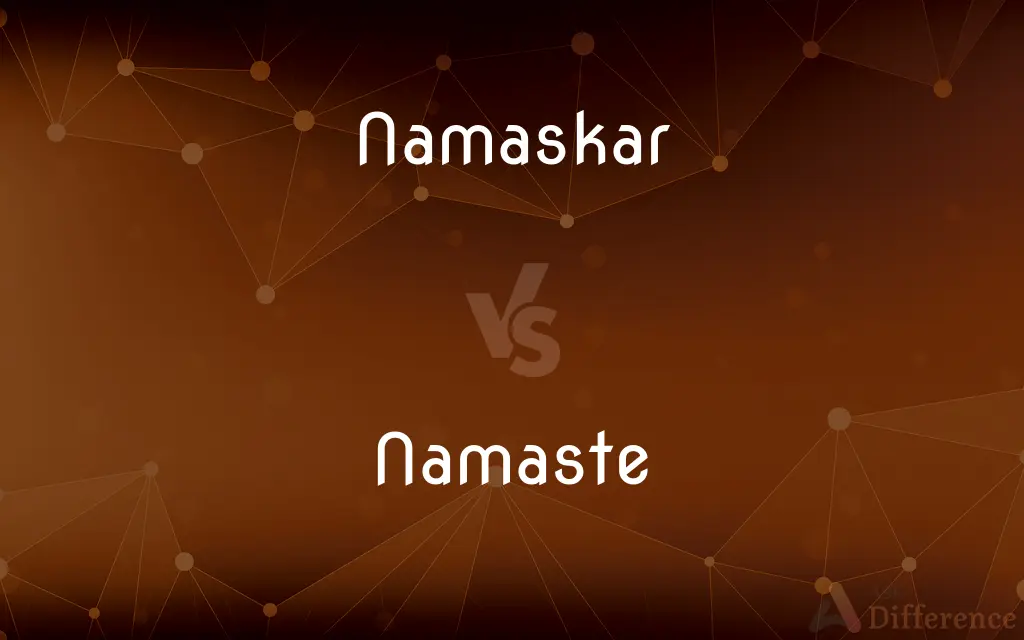Namaskar vs. Namaste — What's the Difference?
By Tayyaba Rehman — Updated on October 28, 2023
Namaskar and Namaste are both traditional Indian greetings; while they are often used interchangeably, Namaskar is a slightly more formal term than Namaste.

Difference Between Namaskar and Namaste
Table of Contents
ADVERTISEMENT
Key Differences
Namaskar and Namaste are traditional greetings in India, often conveying respect. Both stem from Sanskrit and represent a gesture where palms are placed together near the heart, accompanied by a slight bow.
Historically, Namaskar is considered a slightly more formal term. While Namaste is widely recognized globally due to its association with yoga, both words share a deep cultural and spiritual significance in India.
Namaskar is also used in a broader context in some regions. It can be a greeting not just between individuals, but also towards deities in religious settings. Namaste, while holding a spiritual undertone, is commonly used in everyday interactions.
Linguistically, the roots of Namaskar and Namaste are related. "Nama" means "to bow" and both terms signify bowing or showing respect. However, nuances in their use can vary based on regional and social contexts.
Over time, with the global spread of yoga and Indian culture, Namaste has gained significant international recognition. Namaskar, while deeply respected within India, is less known internationally but retains its revered status domestically.
ADVERTISEMENT
Comparison Chart
Formality
Slightly more formal
Commonly used, less formal
Usage in Religion
Often used towards deities
Less commonly used in religious context
Global Recognition
Less globally recognized
Widely recognized due to yoga
Linguistic Roots
"Nama" means to bow; signifies showing respect
Similar roots; means bowing to the divine in someone
Regional Variations
Usage can vary based on region in India
Consistently used across regions
Compare with Definitions
Namaskar
A traditional Indian greeting signifying respect.
He gave a Namaskar upon entering the temple.
Namaste
A salutation often associated with yoga practices.
The yoga class began and ended with a Namaste.
Namaskar
A customary gesture towards deities in religious settings.
She offered Namaskar to the idol.
Namaste
A common Indian gesture of respect and greeting.
She said Namaste as she met her friend.
Namaskar
A formal acknowledgment or salutation.
We begin our day with a Namaskar to the sun.
Namaste
Expressing honor and gratitude.
With folded hands, he whispered Namaste.
Namaskar
A term denoting deep reverence.
The disciple gave a Namaskar to his guru.
Namaste
Bowing to the divine presence in another.
With a Namaste, he acknowledged the teacher's wisdom.
Namaskar
A bow or gesture of honor.
The performer gave a Namaskar to the audience.
Namaste
A cultural acknowledgment of another's presence.
The children greeted the elders with a Namaste.
Namaskar
A polite or respectful gesture of greeting or farewell widely used among Hindus and made by pressing the palms together at an upward angle in front of the chest and generally accompanied by a slight bow.
Namaste
Namaste (, Devanagari: नमस्ते, Sanskrit pronunciation: [nəməst̪eː] (listen)), sometimes spoken as namaskar and namaskaram, is a customary, non-contact form of respectfully greeting and honoring the opposite person or group, used at any time of day. Today, it is found on the Indian subcontinent, Southeast Asia and among the Indian diaspora worldwide.
Namaskar
Used to express a polite or respectful greeting or farewell.
Namaste
Used especially among Hindus to express a polite or respectful greeting or farewell.
Namaskar
(India) The use of the greeting in which one puts one's hands together and bows slightly; greeting with a namaste.
Namaste
A greeting only in Indian culture-related or New Age contexts and Indianized literature
Namaste
The traditional greeting when saying the word namaste, with folded hands and a slight bow.
Namaste
In yoga, the pose associated with this word, usually with the flat hands held palms together, fingers up, in front of the heart and a slight bow.
Namaste
(intransitive) To utter "namaste".
The yoga instructor namasted, and the class began.
Common Curiosities
Are Namaskar and Namaste synonymous?
While often used interchangeably, Namaskar is slightly more formal than Namaste.
Are both terms from Sanskrit?
Yes, both Namaskar and Namaste have Sanskrit origins.
Which term is older?
Both terms are ancient, but nuances in use have evolved over time.
Is Namaste exclusive to yoga?
No, while Namaste is popular in yoga, it's a common greeting in India.
Which is more globally recognized?
Namaste is more globally recognized, mainly due to yoga.
How are the terms pronounced?
Namaskar is pronounced as "nah-mahs-kar" and Namaste as "nah-mah-stay."
Do the terms have spiritual undertones?
Yes, both terms carry a spiritual significance of recognizing and honoring the divine in another.
Can Namaskar be used in religious contexts?
Yes, Namaskar is often used to show reverence to deities.
Is Namaskar specific to any region in India?
Its use can vary, but it's recognized across India.
Can Namaste be used formally?
Yes, though Namaskar is considered slightly more formal.
How are these terms used in daily life in India?
Both are common greetings, with Namaste being more universally used.
Are the gestures the same for both terms?
Generally, yes. Palms are placed together near the heart, accompanied by a slight bow.
How should one respond when greeted with Namaskar or Namaste?
It's respectful to reply with the same greeting and gesture.
Are there other similar greetings in India?
Yes, India has a rich linguistic diversity, so greetings vary across languages and regions.
Has Namaste's meaning changed over time?
While its essence remains, its global association with yoga is a newer development.
Share Your Discovery

Previous Comparison
Luggage vs. Baggage
Next Comparison
Chilled vs. ColdAuthor Spotlight
Written by
Tayyaba RehmanTayyaba Rehman is a distinguished writer, currently serving as a primary contributor to askdifference.com. As a researcher in semantics and etymology, Tayyaba's passion for the complexity of languages and their distinctions has found a perfect home on the platform. Tayyaba delves into the intricacies of language, distinguishing between commonly confused words and phrases, thereby providing clarity for readers worldwide.
















































